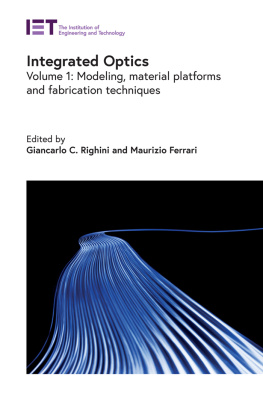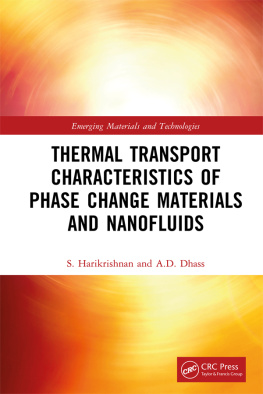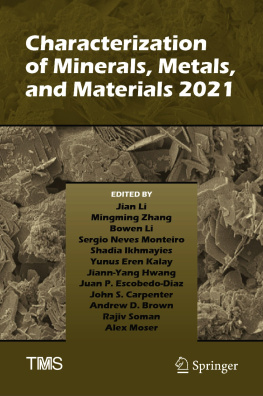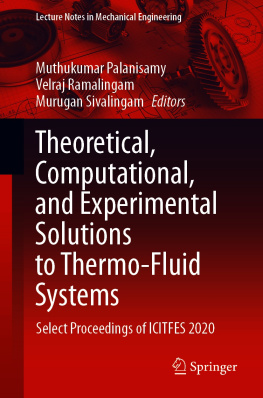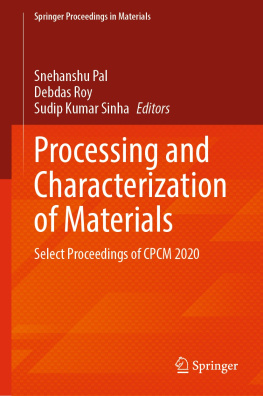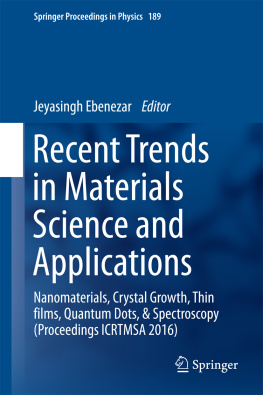M C
Premier Materials Characterization MethodsA. Kanni Raj
Copyright @ 2016
PREFACEThis BOOK manuscript is written in order to use it as lecture notes to thecourse entitled TECHNIQUES OF MATERIALS CHARACTERISATIONgiven at PSN College of Engineering and Technology (Autonomous) Tirunelveli /Tamil Nadu / India for M.E. (CRYOGENIC ENGINEERING).
Again to add, this book can be used as textbook for TECHNIQUES OFMATERIALS CHARACTERISATION given at various colleges affiliatedto Anna University -Chennai /Tamil Nadu / India for Ph.D. (PHYSICAL SCIENCES).
This book contains FIVE CHAPTERS, viz., Chapter I THERMAL ANALYSIS, Chapter II OPTICAL MICROSCOPY, Chapter III ELECTRON MICROSCOPY, Chapter IV - ELECTRICAL METHODS and Chapter V SPECTROSCOPIC ANALYSIS. This book contains 100% lecture notes to explain M C (PREMIER MATERIALSCHARACTERISATION METHODS).
Though not highly descriptive or comprehensive, this book covers centper cent examination items for M.E.(Cryogenicl Engineering) as per PSNCollege of Engineering and Technology - Turunelveli and for Ph.D.(Physical Sciences) of Anna University Chennai.
Author would like to thank his wife Shreemathi - M. Subbu LakshmiB.Sc.(Biology) & M.A.(Tamil) for the painstaking effort in typing thismanuscript and helping in this book publishing venture.
CONTENTSPREFACECHAPTER 1 THERMAL ANALYSIS
1.1 Basic Thermal Analysis Concepts
1.2 - Thermogravimetric Analysis
1.3 - Differential Thermal Analysis
1.4 - Differential Scanning Calorimetry
1.5 - Specific Heat Capacity
1.6 - Thermomechanical Parameters
CHAPTER 2 OPTICAL MICROSCOPY
2.1 - Optical microscopic techniques
2.2 - Bright field optical microscopy
2.3 - Dark field optical microscopy
2.4 Dispersion staining and interference microscopy
2.5 - Phase contrast microscopy
2.6 - Differential interference contrast microscopy
2.7 - Fluorescence microscopy
2.8 - Confocal microscopy
2.9 - Scanning probe microscopy
2.10 - Scanning new field optical microscopy
2.11 - Digital holographic microscopy
2.12 - Oil immersion objectives
2.13 - Quantitative metallography
2.14 - Image analyzer
CHAPTER 3 ELECTRON MICROSCOPY
3.1 Scanning Electron Microscopy
3.2 Energy Dispersive Analysis using X-rays
3.3 Electron Probe Micro Analysis
3.4 Transmission Electron Microscopy
3.6 Photoluminescence and Electroluminescence
CHAPTER 4 ELECTRICAL METHODS
4.1 Hall effect the two probe method
4.2 - Four probe van der Pauw method
4.3 - Hall probe and measurement
4.4 Hall C-V characteristics and impurity concentration
4.5 - Electrochemical C-V profile
CHAPTER 5 SPECTROSCOPIC ANALYSIS
5.1 - UV-Visible-IR Spectroscopy
5.2 Fourier Transform IR Spectroscopy
5.3 - Raman Spectroscopy
5.4 Electron Spin Resonance Spectroscopy
5.5 Nuclear Magnetic Resonance Spectroscopy
5.6 Nuclear Quadrupole Resonance Spectroscopy
5.7 X-ray Photoelectron Spectroscopy
5.8 - Auger Electron Spectroscopy
5.9 - Secondary Ion Mass Spectrometry
5.10 Particle Induced X-ray Emission Spectroscopy
5.11 Rutherford Backscattering Spectrometry
REFERENCESBLURB
CHAPTER I - THERMAL ANALYSIS
1.1 Basic Thermal Analysis ConceptsIntroduction The term thermal analysis (TA) is frequently used todescribe analytical experimental techniques which investigate thebehaviour of a sample as a function of temperature. This definition is toobroad to be of practical use. In this book, TA refers to conventional TAtechniques such as differential scanning calorimetry (DSC), differentialthermal analysis (DTA), thermogravimetry (TG), thermomechanicalanalysis (TMA) and dynamic mechanical analysis (DMA). A selection of representative TA curves is presented in Figure 1.1.1. TA, in its various guises, is widely employed in both scientific and industrial domains. Theability ofthese techniques to characterize, quantitatively and qualitatively,a huge variety of materials over a considerable temperature range hasbeen pivotal in their acceptance as analytical techniques. Under normalconditions only limited training of personnel is required to operate a TAinstrument. This, coupled with the fact that results can be obtained relatively quickly, means that TA is employed in an ever increasingrange of applications. However, the operational simplicity of TAinstruments belies the subtlety of techniques which, if improperlypractised, can give rise to misleading or erroneous results. Theabundance of results of dubious integrity in both the academic literatureand industrial performance reports underlines the extent andseriousness of this problem.
Characteristics The advantages of TA over other analytical methods can be summarized as follows: (i) the sample can be studied over a wide temperature range using various temperature programmes; (ii) almost any physical form of sample (solid, liquid or gel) can be accommodatedusing a variety of sample vessels or attachments; (iii) a small amount of
-10 mg) is required; (iv) the atmosphere in the vicinity ofthe sample can be standardized; (v) the time required to complete anexperiment ranges from several minutes to several hours; and (vi) TAinstruments are reasonably priced. In polymer science, preliminaryinvestigation of the sample transition temperatures and decompositioncharacteristics is routinely performed using TA before spectroscopic analysis is begun.
TA data are indirect and must be collated with results from spectroscopic measurements [for example NMR, Fourier transform infrared (FTIR)spectroscopy, X-ray diffractometry] before the molecular processes responsible for the observed behaviour can be elucidated. Irrespectiveof the rate of temperature change, a sample studied using a TAinstrument is measured under nonequilibrium conditions, and theobserved transition temperature is not the equilibrium transitiontemperature. The recorded data are influenced by experimental parameters, such as the sample dimensions and mass, theheating/cooling rate, the nature and composition of the atmosphere inthe region of the sample and the thermal and mechanical history of thesample. The precise sample temperature is unknown during a TAexperiment because the thermocouple which measures the sampletemperature is rarely in direct contact with the sample. Even when indirect contact with the sample, the thermocouple cannot measure themagnitude of the thermal gradients in the sample,

Figure 1.1.1 - Representative TA curves
which are determined by the experimental conditions and the instrument design. The sensitivity and precision of TA instruments to thephysicochemical changes occurring in the sample are relatively low compared with spectroscopic techniques. TA is not a passiveexperimental method as the high-order structure of a sample (forexample crystallinity, network formation, morphology) may changeduring the measurement. On the other hand, samples can be annealed, aged, cured or have their previous thermal history erased using theseinstruments.
Instruments - The general conformation of TA apparatus, consisting ofa physical property sensor, a controlled-atmosphere furnace, atemperature programmer and a recording device, is illustrated in Figure1.1.2. Table 1.1.1 lists the most common forms of TA. Modern TAapparatus is generally interfaced to a computer (work station) whichoversees operation of the instrument controlling the temperature range, heating and cooling rate, flow of purge gas and data accumulation andstorage. Various types of data analysis can be performed by thecomputer. A trend in modern TA is to use a single work station tooperate several instruments simultaneously (Figure 1.1.3). TA apparatus without computers is also used where the analogue output signal isplotted using a chart recorder. Data are accumulated on chart paper and calculations performed manually. The quality of the data obtained is notdiminished in any way. The accuracy of the results is the same providedthat the apparatus is used properly and the data are analysed correctly.Some in struments are equipped with both a computer and a chart recorder in order, for example, to evaluate ambiguous shifts in thesample baseline.


